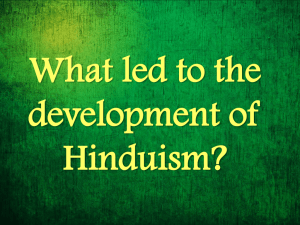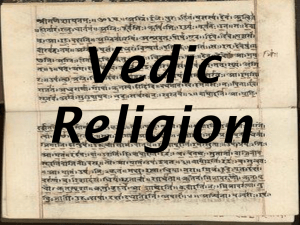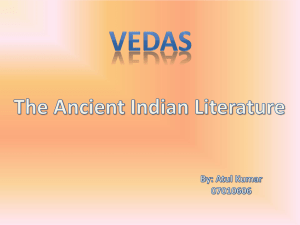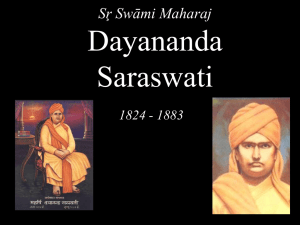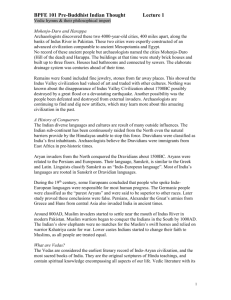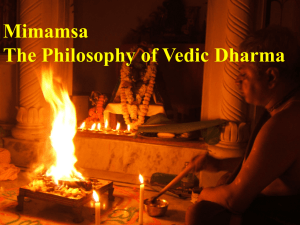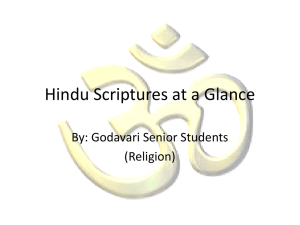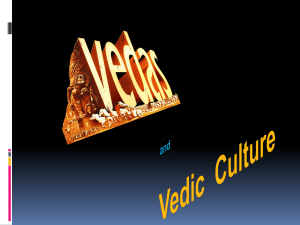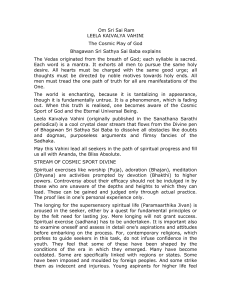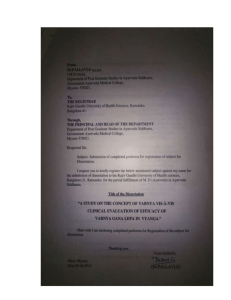Vedic Literature: An Introduction to the Vedas
advertisement
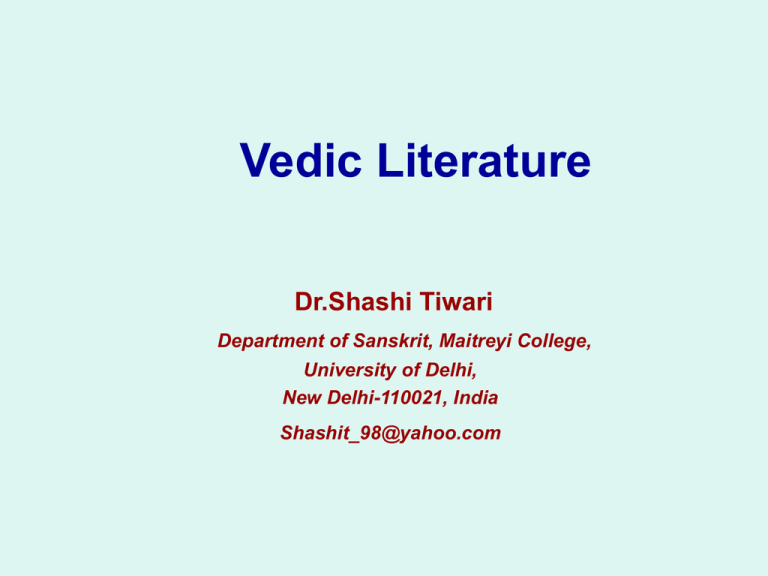
Vedic Literature Dr.Shashi Tiwari Department of Sanskrit, Maitreyi College, University of Delhi, New Delhi-110021, India Shashit_98@yahoo.com Ancient India The survey of periods in ancient India (historically four periods) • The first period, from the prehistoric times to 3000 B.C or so. -( Vedic age) • The second period, from 3000 to 1000 B.C. - ( Later Vedic Age ) • The third period, from 1000 B.C. to 500 A.D. - (Age of Epics) • The fourth period, from 500 A.D. to 1200 A.D. - (Age of Puranas and Kavyas) NO ONE CAN DECIDE THE EXACT TIME OF VEDAS 2 Ancient University Harshavardhana receiving XuanZang, at Nalanda Remains at Nalanda 3 Ancient Sanskrit Literature Two Main DivisionsI. Vedic literature- • • Called Mantras Reveled by Rishis • In Vedic Language ( not regulated by Panini) II. Classical Sanskrit literature • • • Called Kavyas, Adikavya Ramayana of Valmiki Written by Kavis In Sanskrit language (regulated by Panini) 4 Meaning of the 'Veda' • • • • The word 'Veda' means 'knowledge' Derived from the Sanskrit root ‘vid' to know. Denotes works containing knowledge (Vidya) The most sacred and authoritative knowledge Veda is, therefore, a Book of Knowledge The word 'Veda' does not refer to one single literary work, but indicates a whole great literature 5 Veda as Shruti 'Veda' is called ‘Shruti’ • Shruti meaning what is ‘heard’ • Not what is written or remembered • Indian tradition says 'Veda' is: -A revealed scripture, -self-evident, and -self authoritative. • Not composed by any human authors. • As opposed to the Shruti, there is Smriti or traditional works of human origin 6 Definitions of Veda 1‘Ishtaprapti-anishtapariharyoralaukikam-upayam yo grantho vedayati sa vedah.’ -Sayana - The scripture, which describes the divine method for obtaining what is desirable and for giving up what is undesirable, is called Veda. 2. ‘Mantra-brahamanyor-vedanamadheyam’ -The Veda is the name given to the Mantras and the Brahmanas’ • • No adequate definition of the Veda. Generally 'Veda' signifies highest, sacred, and divine knowledge as well as the works containing that knowledge. 7 Importance of Vedas (1) Significance of Vedas due to many facts: • Earliest recorded poetry and prose literature of the human race • Authoritative knowledge- basis of Indian Religion or philosophy -'Aastika' who have faith in Veda; 'Naastika' do not have faith in Veda. • Root of Culture of the Hindus & Indians 8 Importance of Vedas (2) Contains Spiritual knowledge & knowledge of all sorts /worldly • The Veda is the only unadulterated treasure house of true knowledge • The Vedic language carry some deep hidden meanings &symbolic impression • Many commentaries and books to understand its difficult concepts 9 Preservation of the Veda(1) Despite being oldest, the Vedas have been preserved in their true form up till now. F. Max Muller, a renowned European scholar, has admitted that, “the text of the Vedas has been handed down to us with such accuracy and care that there is hardly any change in the words, or there is any uncertain aspect in the whole of Vedas. The credit for this goes to Vedic seers (Rishis) who devised means of protecting and preserving the text of Vedas letter by letter”. 10 Preservation of the Veda (2) Means for preserving text & meaning of Vedic mantras: • Vedic accents (Swara) protects words • Eight Vikritis used for memorizing – Jatapatha, Malapatha, Shikhapatha, Rekhapatha, Dhvajapatha, Dandapatha, Rathapatha and Ghanapatha • Three Pathas used for memorizing – Samhita-Patha,Pada-Patha ,Krama-Patha • Treatises known as Anukraminis • Brahmanas and Vedangas ‘ Since that remote time, the text of the Vedas has suffered no change’. A .A. Macdonell - History of Sanskrit Literature 11 Apaurusheyata of the Veda According to ancient conception: • The Vedas are not the creation of any human being. They are visualized, seen or revealed. • They are Apaurusheya. • Rigveda describes Vedas as eternal‘Vachaa virupa nityataa’ – Rigveda 8.76.6 • Vedanta Philosophy states: ' Vedas are just like expiration ( Nihshvaasa) of that great Brahman.' 12 Age of the Veda(1) Rigveda: most ancient document but fixing age is difficult, due to problems,as• There is no outside evidence available as inscription, seals etc. • Dates are not mentioned in the Vedic texts. • The doctrine of 'Apaurusheyata' shows them eternal. • Vedic astronomical accounts are not very clear. • View of scholars differ. On the basis of Boghazkoi inscription (1400 B.C.) found in Asia Minor, we may consider the latest limit of the Vedic age before 1400 B.C. 13 Opinions of Scholars on Age(2) Name of the scholar Source Age of the Vedas 1.Swami Dayananda - Vedas -Beginning of the Creation 2. Dinanath Shastri - Astronomy 3 lakhs years back 3. AvinashChandraDas -Geology -25000 B.C. 4.Balgangadhar Tilak -Astronomy - 6000 B.C. 5. R.G. Bhandarkar -Vedic-mantras -6000 B .C. 6. Shankar Balkrishna Dikshit -Astronomy -3500 B.C. 7.H. Jacobi -Astronomy -4500 B.C. 8. M. Winternitz -Boghazkoi -2500 B.C. 9. F.Maxmuller -Buddhist Literature -1200 B.C. 14 Division of the Vedic Literature(1) • 'Veda' is a collective term indicating four Vedas: - Rigveda, Yajurveda, Samaveda and Atharvaveda. • Broadly speaking the Vedic literature has two categories: 1. The Vedas 2. The Vedangas • Each of these classes has number of texts. 15 Division of the Vedic Literature(2) • (1).Samhitas- collections, namely collections of hymns and Mantras • (2). Brahmanas-voluminous prose texts, related to sacrificial rites and ceremonies • (3). Aranyakas -forest texts, contain chiefly the meditations of forest-hermits and deal with mysticism of sacrifices • (4). Upanishads- secret doctrines partly included in other Vedic texts and partly reckoned as independent works 16 Four Vedic Samhitas 1. Rigveda-Samhita = collection of the Riks 2. Samaveda-Samhita= collection of the Samans 3. Yajurveda-Samhita= collection of the Yajush It has two versionsA. Shukla-Yajurveda-Samhita B. Krishna-Yajurveda-Samhita 4. Atharvaveda-Samhita = collection of the Atharvan 17 Rigveda-Samhita- Nature • Oldest Samhita ‘ A Collection of Rik Mantras’ 18 Rigveda-Samhita - Importance • • • • • • • Earliest ,sacred book of India ,Biggest amongst all the four Vedas Foundation of India's religion Philosophy. Helps to understand Indian literature and culture. Its language & mythology help to understand languages, literatures and cultures of the world. Rik mantras to please deities Rigveda is a systematically arranged Samhita. 19 Rigveda-Samhita – Division (1) • Today only one recession (Shakha) of the Rigveda is available i.e. Shaakala • The Rigveda Samhita contains about 10552 Mantras. • Mantras are classified into ten books called Mandala. • Each Mandala is divided into sections called Anuvakas. • Each Anuvaka consists of hymns called Suktas. • Each Sukta has a number of verses called riks. TOTAL : 10 Mandalas, 85 Anuvakas, 1028 Suktas and 10552 Mantras. 20 Rigveda-Samhita – Division ( 2) • • • • • • • • • • Mandalas with Names of Rishis (7 Kula-Mandala) 1 Mandala Many Rishis 2 Mandala Gritasamada 3 Mandala Vishvamitra 4 Mandala Vamdeva 5 Mandala Atri 6 Mandala Bhardwaja 7 Mandala Vashishtha 8 Mandala Kanva & Angira 9 Mandala Devata Soma 10 Mandala Many Rishis 21 Rigveda Samhita- First Sukta 22 Some Hymns of Rigveda • • • • • • • • Purusha Sukta Hiranya-garbha Sukta Dhana-anna-dana Sukta Aksha Sukta Nasadiya Sukta Duhsvapna-nashna Sukta Yama-yami-samvada Sukta Besides, there are Suktas offered to different deities, such as, Indra, Maruta, Varuna, Usha, Surya, Bhumi, Soma, Agni etc. 23 Samaveda Samhita -Nature • Shortest of all the four Vedas • Closely connected with Rigveda • Samaveda is considered as an independent collection (Samhita) • 'melody is called Saman.' ‘Gitishu saamakhya- Jaiminiya Sutra. • Its Verses are chanted at Soma-sacrifice. • It is intended for the Udagata priest. 24 Samaveda Samhita-Importance Veda Trayi - three Vedas- Rig, Sama,Yajush • Rigveda- Jnana or knowledge, • Yajurveda- Karma or action, • Samaveda - Bhakti or devotion. • Samaveda is the foremost. "Among the Vedas I am Samaveda"Vedanama Samavedo'smi -Gita, 10.22. • Indra, Agni and Soma deities are invoked, devotion and musical chanting • Samagana for higher spirituality, grace of god 25 Samaveda Samhita - Shakhas According to Patanjali, the Samaveda had 1000 Shakhas. • Today only three recessions are available: (1) Kauthuma, (2) Jaiminiya, (3) Ranayaniya Kauthuma Shakha is well known. 26 Samaveda Samhita - Division • The Samaveda-Samhita consists of two parts: 1. Purvarcika, 2. Uttararcika. • Purvarcika (650 verses) contains four parts: (1). Agneya - verses for Agni (2) Aindra - verses for Indra (3) Pavamana - verses for Soma Pavamana (4) Aranya - verses for Indra, Agni, Soma etc. • The Uttararcika contains 1225 verses. Total verses of Samaveda-Samhita are 1875. Only 99 verses are new to this Samhita ,Rest are from Rigveda. 27 Yajurveda Samhita - Nature • • • • • Yajurveda is Veda of Yajush Quite different from the first two Samhitas. It is principally in prose form. The word 'Yajush' is explained variously. One definition says - 'Gadyatmako yajuh'. ‘which is in prose form'. Another definition – ‘Yajur Yajate’ ‘related with the sacrifice (Yajna)’ 28 Yajurveda Samhita - Importance • • • • Yajurveda is mainly a ritual Veda A guide-book for the Adhvaryu priest‘ who had to do practically all ritualistic works in a sacrifice’. It is solely meant for the purpose of sacrificial rituals. It is important for its philosophical doctrines. It is known for giving certain geographical data. 29 Yajurveda Samhita –Division(1) The Yajurveda is two-fold1. The White Yajurveda- Shukla (Aditya School) 2. The Black Yajurveda- Krishna (Brahma school)1 (1)Yajush vomited, were taken by pupils in the form of Tittiri. Yajush, dark, black , Kishna = Taittiriya. (2) Yajyavalkya prayed to the Sun, who in the form of Vaji gave him new Yajush. This Yajush ,white, pure, Shukla = Vajasaneyi. Story of Rishi Vaishampayana and Rishi Yajyavalkya 30 Yajurveda Samhita –Division(2) *Sukla Yajurveda has two Samhitas * Krishna Yajurveda has four Sanhitas: (1)Shukla Yajurveda- 1.Madhyandina Samhita 2. Kanva Samhtia (2)Krishna Yajurveda1. Taittiriya Samhita 2.Kathaka Samhita 3. Kapishthala Samhita 4. Maitrayani Samhita 31 Yajurveda Samhita –Contents Some names of sacrifices: - Darsha-purnamasa, Agnihotra, Somayaga, Chaturmasya, Agnihotra, Vajapeya, Ashvamedha, Sarvamedha,Brahmayajya, Pitrimedha, Sautramani etc. • Somayaga and Agnicayanas. Philosophical Portions: • Ishavasya-Upanishad, Shivasankalpa Sukta 32 Atharvaveda Samhita- Nature • • • • • • • Veda of Atharvan originally means 'priest' (a stable-minded Yogi) Its Ritvij is Brahma Names for Atharvaveda: Angirasaveda, Kshatraveda, Bhaishajyaveda, Chandoveda, Mahiveda Brahmaveda' etc. Today its only two recessions available – Shaunaka and Paippalada It is divided into 20 books (Kandas). Books 15 and 16 are in prose 33 Atharvaveda Samhita-Importance • • • • • Deals with worldly happiness and spiritual knowledge. Sayana praised for fulfilling both. Origin of Ayurveda: Oldest literary text on medicine or medical science. Mantras to cure physical and mental diseases. Application of medicines and medicinal herbs. Philosophical portions: Highest god as creator of the world (Prajapati), Tapas, Asat, Prana, Manas, kala etc terms used 34 Atharvaveda Samhita- Contents Atharvaveda is Veda of varied knowledge. 1.Mantras to the cure of diseases and destruction of adverse forces. 2. Mantras to establish peace, protection, health, wealth, friendship and long life. 3. Mantras to the describe Supreme Reality, time, death and immortality. Bhashijya, Paushtika, Prayashtita, Rajkarma, Stikarma,Darshana, Kuntapa etc. 35 Some Hymns of Atharvaveda • • • • • • • • 1. Bhumi-Sukta (12.1) 2. Brahmacarya-Sukta (11.5) 3. Kala-Sukta (11.53, 54) 4. Vivaha-Sukta (14th Kanda) 5. Madhuvidya-Sukta (9.1) 6. Rohita-Sukta (13.1-9) 7. Skambha-Sukla (10.7) 8. Samanasya-Sukta (3.30) 36 Conclusion • Samhita literature is main part of Vedic Literature. • It is regarded important for its nature, form and contents. • It is a source of all Disciplines of learning 37 OM THANK YOU 38
